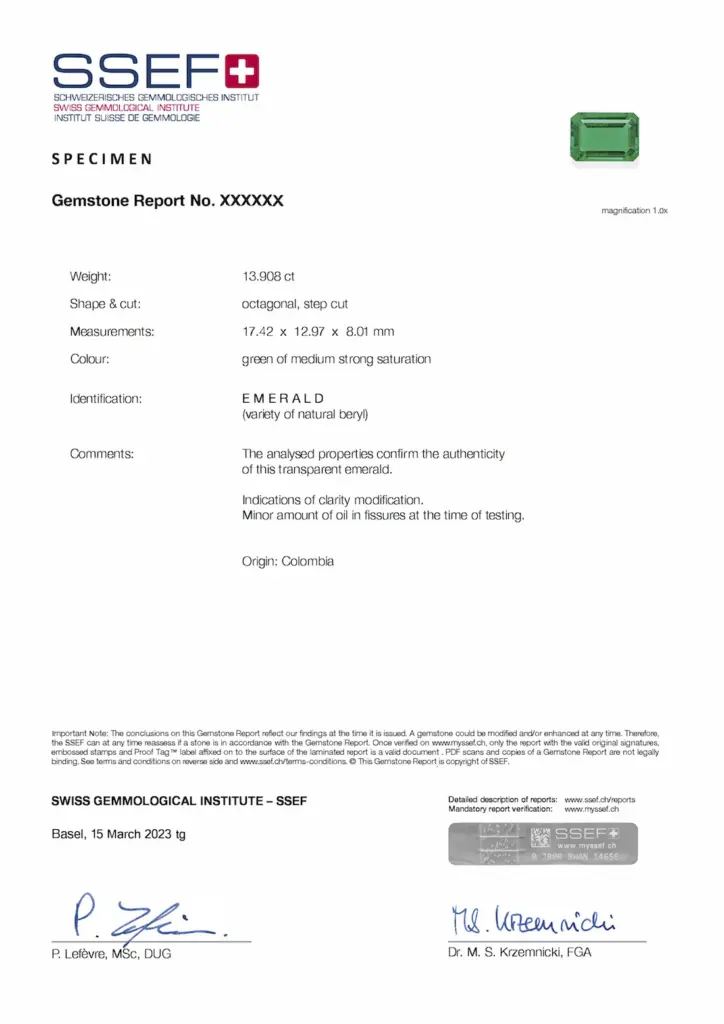Emerald
Emeralds have been revered for millennia, especially for their saturated green colour. Sources range from ancient Egypt, Swat valley (modern Pakistan) and Austria to today’s iconic sources in Afghanistan, Brazil, Colombia and Zambia. Other producers today include Ethiopia and Madagascar.
As a result of their geological history emeralds commonly have fissures. Untreated high-quality emeralds without fissures are very rare. It is a common practice in the trade to treat emeralds by filling them with filler substances that enhance their clarity. Such treatments however need to be disclosed, as outlined in CIBJO’s Blue Books. SSEF has a full disclosure policy, which is why the filling substance (oil, artificial resin etc.) is identified on a report along with the amount of filler present (none, minor, moderate, significant).

Report No & Photo
The SSEF report number is the number given to the item when it is submitted for testing, and is a unique number. If an item is resubmitted later for a ‚recheck‘ after re-cutting or for a report update then the item obtains a new report number.
The photo of an emerald depicts the gem at the time of testing. The photo on an SSEF report is for representational purposes and does not necessarily represent actual colour, clarity or size. For size comparison purposes, approx. magnification used is provided under the photo on the report.
Weight
Weight of an emerald in carats, measured and stated with 3 digits. In the case of mounted jewellery, total weight corresponds to total weight of jewellery item(s) and is stated in grams.
Shape & Cut
The shape and cut describe the outlining shape and cutting style of an examined gemstone. For jewellery items with several stones, a range of shapes and cuts may be stated, if these vary.
Measurements
The measurements are given at 2 decimal places. They generally represent length x width x height of a gemstone. For series of gemstones or gemstones in jewellery, a range of measurements may be stated on the report.
Colour
Colour description on an SSEF report for an emerald describes both the colour hue and the saturation of colour (e.g. green of medium saturation). The saturation scale for emeralds used by SSEF is:
- green of medium saturation
- green of medium strong saturation
- green of strong saturation
SSEF only uses descriptive terms for emeralds (i.e. colour and saturation), but no trade names.
Identification
The identification section of an SSEF report can include the variety name and the mineralogical group name of a gemstone. As such, for emeralds:
- Emerald (natural variety of beryl)
A synthetic emerald would be clearly identified and labeled on a report in the identification section.
Treatment
Emeralds are commonly enhanced (treated) in order to improve their clarity and appearance by reducing the visibility of fissures through the use of (colourless) fillers. Fillers can include oil, wax, natural resin (e.g. Canada balsam) and artificial resin. SSEF has a full disclosure policy stating the filler material (e.g. oil, artificial resin) and the amount of filler present at the time of testing in the examined emerald. The filler quantification scale for emeralds used by SSEF (based on LMHC terminology) is:
- no indications of clarity modification in fissures at the time of testing
- minor amount of oil (or artificial resin etc.) in fissures at the time of testing
- moderate amount of oil (or artificial resin etc.) in fissures at the time of testing
- significant amount of oil (or artificial resin etc.) in fissures at the time of testing
If an insignificant amount of filler (e.g. oil, artificial resin) is present in a stone, this is not mentioned on an SSEF report. This is in line with international LMHC guidelines. If cavities are present in addition to fissures, the report would clearly state the presence of both, and filler quantification is described as minor / moderate / significant.
Origin
Origin determination is an expert opinion. At SSEF origin determination relies on the analysis of microscopic features, trace element concentrations, and spectroscopic data of a coloured gemstone. The measured data pertaining to a specific client stone is then compared with our extensive reference collection and database of coloured gemstones of known origin, and scientific gemmological literature.
Report date & verification
The date corresponds to the date on which gemmological testing of the item was concluded. SSEF reports can be verified on www.myssef.ch